brake fluid Oldsmobile Aurora 1997 Owner's Manuals
[x] Cancel search | Manufacturer: OLDSMOBILE, Model Year: 1997, Model line: Aurora, Model: Oldsmobile Aurora 1997Pages: 404, PDF Size: 20.75 MB
Page 96 of 404
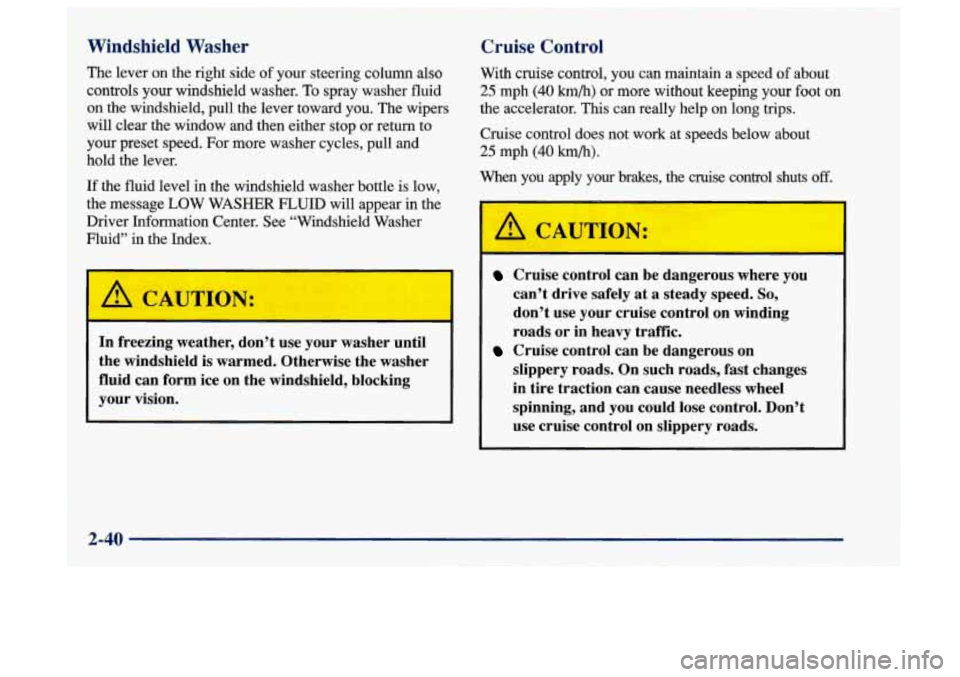
Windshield Washer
The lever on the right side of your steering column also
controls your windshield washer.
To spray washer fluid
on the windshield, pull the lever toward you. The wipers
will clear the window and then either stop or return to
your preset speed. For more washer cycles, pull and
hold the lever.
If the fluid level in the windshield washer bottle is low,
the message
LOW WASHER FLUID will appear in the
Driver Information Center. See “Windshield Washer
Fluid” in the Index.
/d CAUTldN:
In freezing weather, don’t use your washer until
the windshield
is warmed. Otherwise the washer
fluid can form ice on the windshield, blocking
your vision.
Cruise Control
With cruise control, you can maintain a speed of about
25 mph (40 km/h) or more without keeping your foot on
the accelerator.
This can really help on long trips.
Cruise control does not work at speeds below about
25 mph (40 km/h).
When you apply your brakes, the cruise control shuts off.
m
A CAUT1b.J:
Cruise control can be dangerous where you
can’t drive safely at a steady speed. So,
don’t use your cruise control on winding
roads or in heavy traffic.
slippery roads. On such roads, fast changes
in tire traction can cause needless wheel
spinning, and you could lose control. Don’t
use cruise control on slippery roads.
Cruise control can be dangerous on
2-40
Page 126 of 404
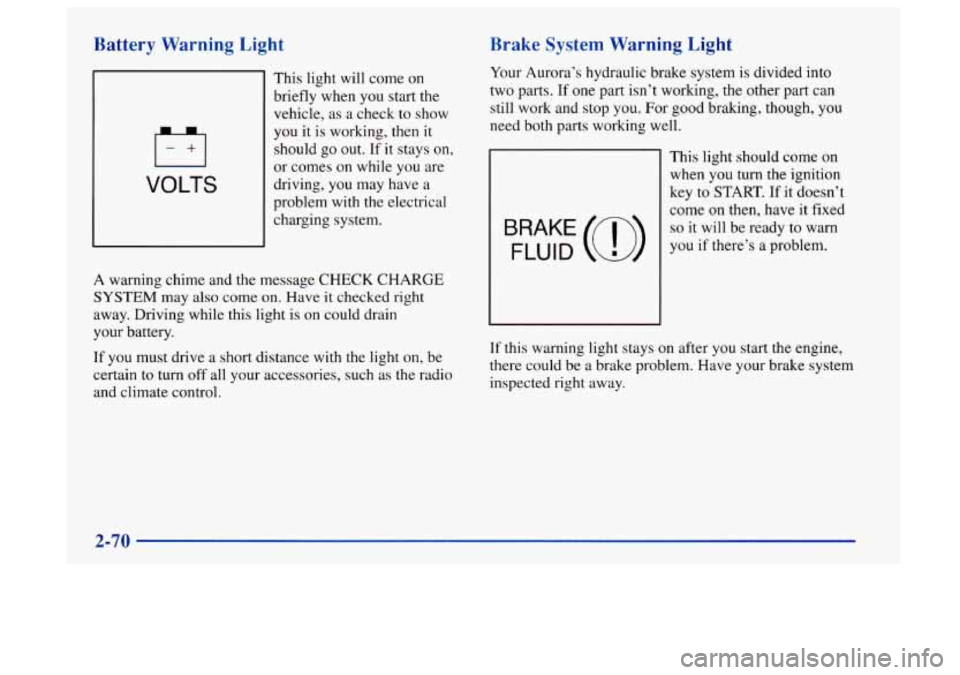
Battery Warning Light
U
VOLTS
This light will come on
briefly when you start the
vehicle, as a check to show
you it is working, then it
should go out. If
it stays on,
or comes on while
you are
driving, you may have a
problem with the electrical
charging system.
A warning chime and the message CHECK CHARGE
SYSTEM may also come on. Have it checked right
away. Driving while this light is on could drain
your battery.
If you must drive a short distance with the light on, be
certain to turn off all your accessories, such as the radio
and climate control.
Brake System Warning Light
Your Aurora’s hydraulic brake system is divided into
two parts. If one part isn’t working, the other part can
still work and stop you. For good braking, though, you
need both parts working well.
This light should come on
when you turn
the ignition
key to
START. If it doesn’t
come
on then, have it fixed
so it will be ready to warn
BRAKE (a) you if there’s a problem. FLUID
If this warning light stays on after you start the engine,
there could be a brake problem. Have your brake system
inspected right away.
2-70
Page 136 of 404
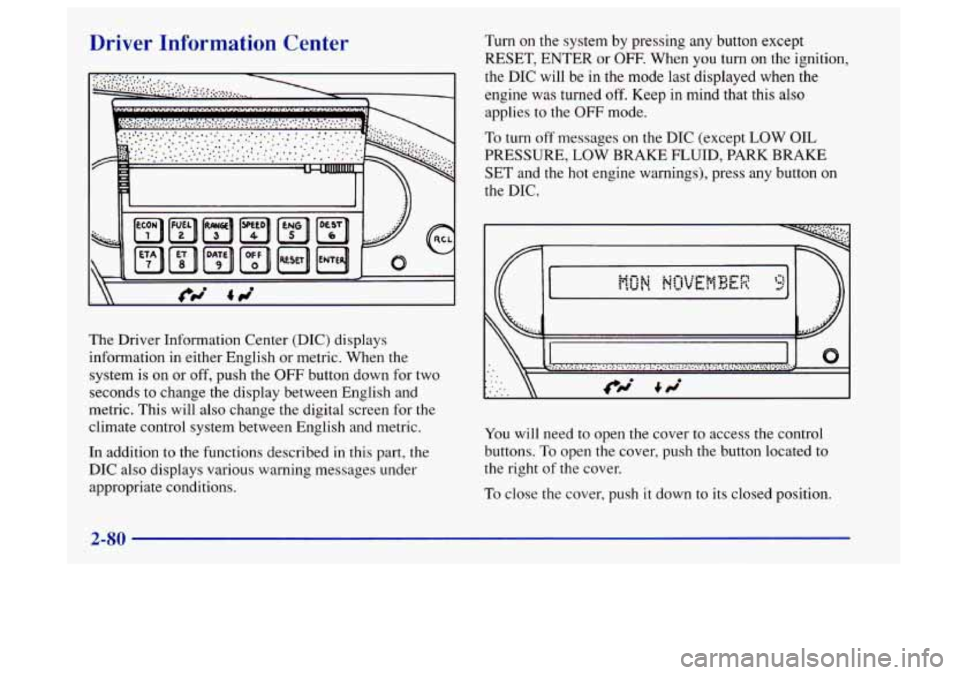
Driver Information Center
The Driver Information Center (DIC) displays
information in either English or metric. When the
system
is on or off, push the OFF button down for two
seconds to change the display between English and
metric. This will also change the digital screen for the
climate control system between English and metric.
In addition to the functions described in this part, the
DIC also displays various warning messages under
appropriate conditions.
Turn on the system by pressing any button except
RESET, ENTER or
OFF- When you turn on the ignition,
the DIC will be in the mode
last displayed when the
engine was turned
off. Keep in mind that this also
applies to the
OFF mode.
To turn off messages on the DIC (except LOW OIL
PRESSURE,
LOW BRAKE FLUID, PARK BRAKE
SET and the hot engine warnings), press any button on
the DIC.
0
You will need to open the cover to access the control
buttons.
To open the cover, push the button located to
the right of the cover.
To close the cover, push it down to its closed position.
2-80
Page 201 of 404
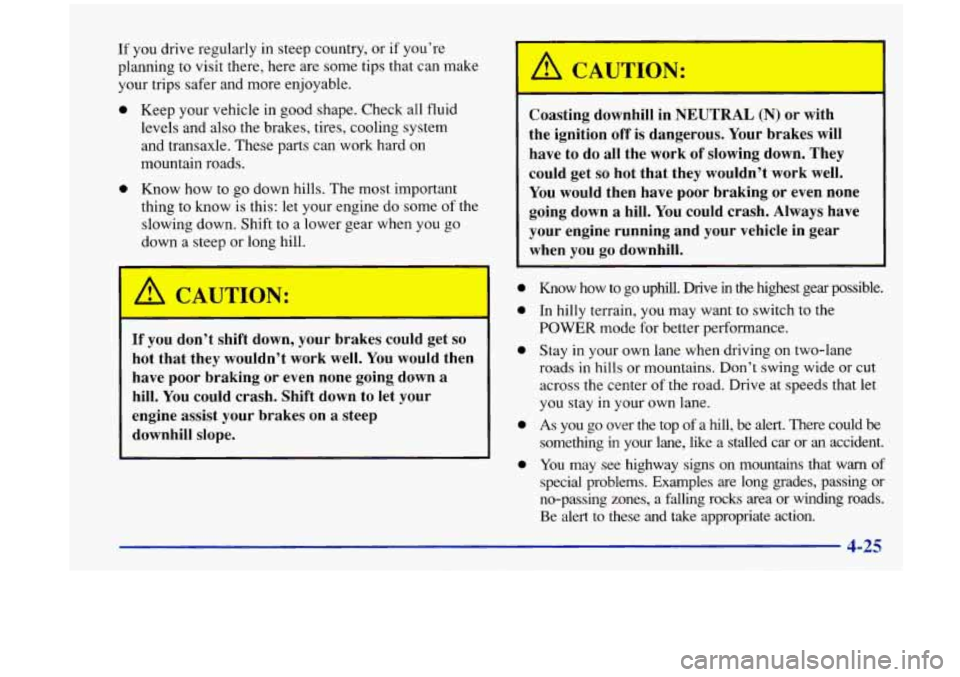
0
0
If you drive regularly in steep country, or if you’re
planning to visit there, here are some tips that can make
your trips safer and more enjoyable.
Keep your vehicle in good shape. Check all fluid
levels and also the brakes, tires, cooling system
and transaxle. These parts can work hard on
mountain roads.
Know how to
go down hills. The most important
thing to know is this: let your engine do some of the
slowing down. Shift
to a lower gear when you go
down a steep or long hill.
~ If you don’t shift down, your brakes could get so
hot that they wouldn’t work well. You would then
have poor braking or even none going down
a
hill. You could crash. Shift down to let your
engine assist your brakes on
a steep
downhill slope.
I
Coasting downhill in NEUTRAL (N) or with
the ignition off is dangerous. Your brakes will
have to
do all the work of slowing down. They
could get
so hot that they wouldn’t work well.
You would then have poor braking or even none
going down
a hill. You could crash. Always have
your engine running and your vehicle in gear
when you go downhill.
0
0
0
0
0
Know how to go uphill. Drive in the highest gear possible.
In hilly terrain, you may want to switch to the
POWER mode for better performance.
Stay in your own lane when driving on two-lane
roads
in hills or mountains. Don’t swing wide or cut
across the center of the road. Drive at speeds that let
you stay
in your own lane.
As you go over the top of a hill, be alert. There could be
something in your lane, like a stalled car or
an accident.
You may see highway signs on mountains that warn of
special problems. Examples are long grades, passing or
no-passing zones, a falling rocks area or winding roads.
Be alert
to these and take appropriate action.
Page 214 of 404

But if you ever have to park your rig on a hill, here’s
how to do it:
3. When the wheel chocks are in place, release the
regular brakes until the chocks absorb the load.
4. Reapply the regular brakes. Then apply your parking
5. Release the regular brakes.
brake,
and then shift to PARK
(P).
When You Are Ready to Leave After
Parking on a Hill
1. Apply your regular brakes and hold the pedal down
while you:
0 Start your engine;
0 Shift into a gear; and
0 Release the parking brake.
2. Let up on the brake pedal.
3. Drive slowly until the trailer is clear of the chocks.
4. Stop and have someone pick up and store the chocks.
Maintenance When Trailer Towing
Your vehicle will need service more often when you’re
pulling a trailer. See the Maintenance Schedule for more
on this. Things that are especially important in trailer
operation are automatic transaxle fluid (don’t overfill),
engine oil, belt, cooling system and brake adjustment.
Each
of these is covered in this manual, and the Index
will help you
find them quickly. If you’re trailering, it’s
a good idea
to review these sections before you start
your trip.
Check periodically to see that all hitch nuts and bolts
are tight.
4-38
Page 253 of 404
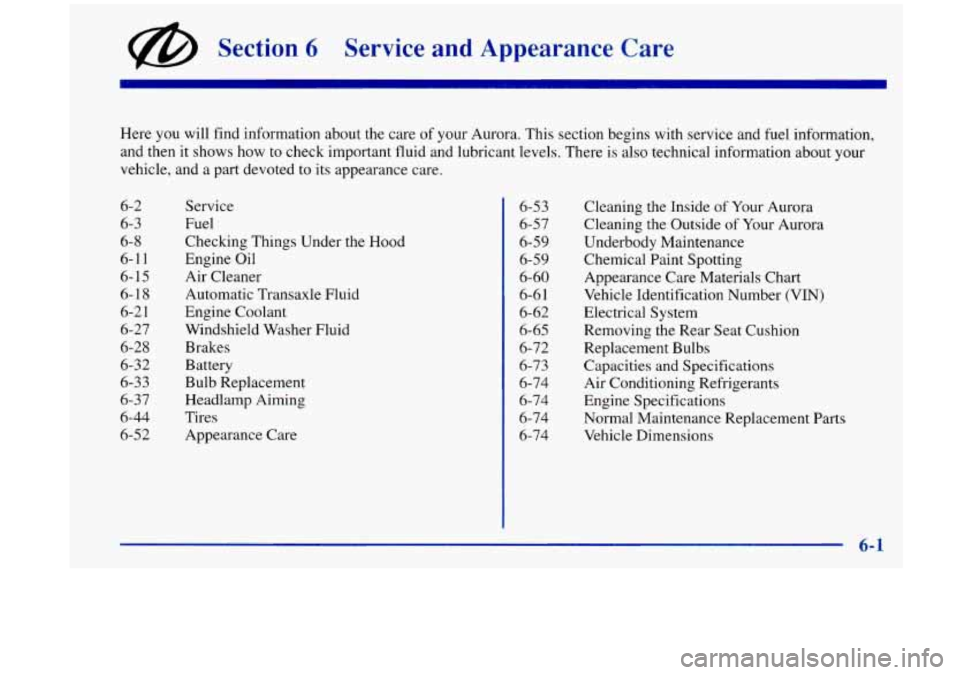
@ Section 6 Service and Appearance Care
Here you will find information about the care of your Aurora. This section begins with service and fuel information,
and then it shows how to check important fluid and lubricant levels. There is also technical information about your
vehicle, and a part devoted to its appearance care.
6-2
6-3
6-8
6-1 1
6-15 6-18
6-2
1
6-27
6-28
6-32
6-33
6-3 7
6-44
6-52 Service
Fuel
Checking Things Under the Hood
Engine Oil
Air Cleaner
Automatic Transaxle Fluid
Engine Coolant Windshield Washer Fluid
Brakes
Battery
Bulb Replacement
Headlamp Aiming
Tires
Appearance Care 6-53
6-57
6-59
6-59
6-60 6-6 1
6-62
6-65
6-72
6-73
6-74
6-74
6-74
6-74 Cleaning the
Inside
of Your Aurora
Cleaning the Outside
of Your Aurora
Underbody Maintenance Chemical Paint Spotting
Appearance Care Materials Chart
Vehicle Identification Number (VIN)
Electrical System
Removing the Rear Seat Cushion
Replacement Bulbs
Capacities and Specifications
Air Conditioning Refrigerants
Engine Specifications
Normal Maintenance Replacement Parts
Vehicle Dimensions
6-1
Page 260 of 404
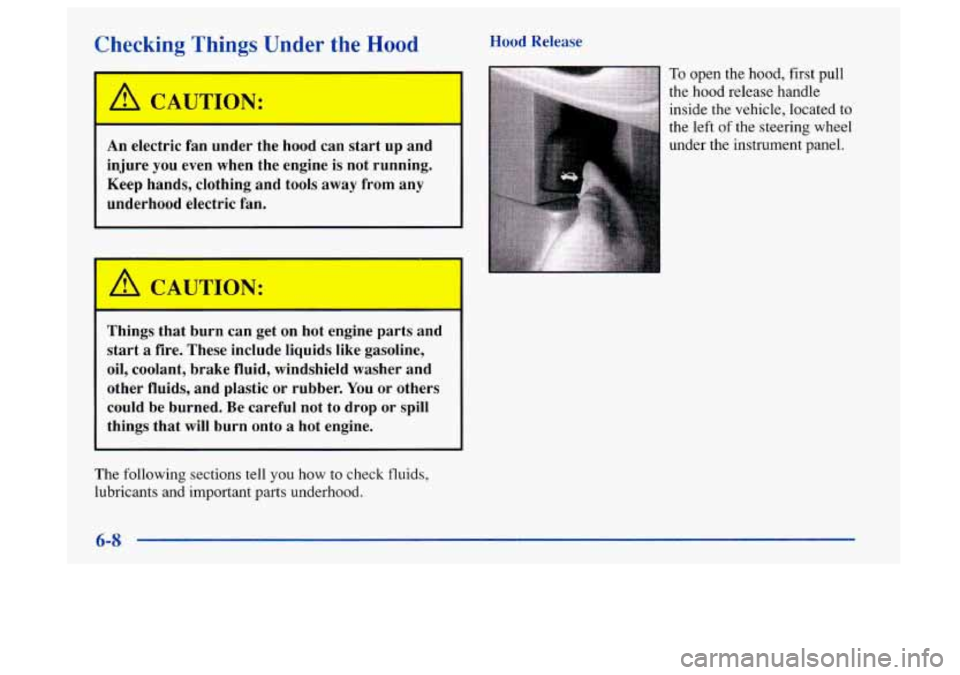
Checking Things Under the Hood
I k!, CAUTION:
An electric fan under the hood can start up and
injure you even when the engine is not running.
Keep hands, clothing and tools
away from any
underhood electric fan.
1
I
Things that burn can get on hot engine parts and start
a fire. These include liquids like gasoline,
oil, coolant, brake fluid, windshield washer and
other fluids, and plastic
or rubber. You or others
could be burned. Be careful not to drop or spill
things that will burn onto
a hot engine.
The following sections tell you how
to check fluids,
lubricants and important parts underhood. Hood Release
To open the hood,
first pull
the
hood release handle
inside the vehicle, located
to
the left of the steering wheel
under the instrument panel.
6-8
Page 262 of 404
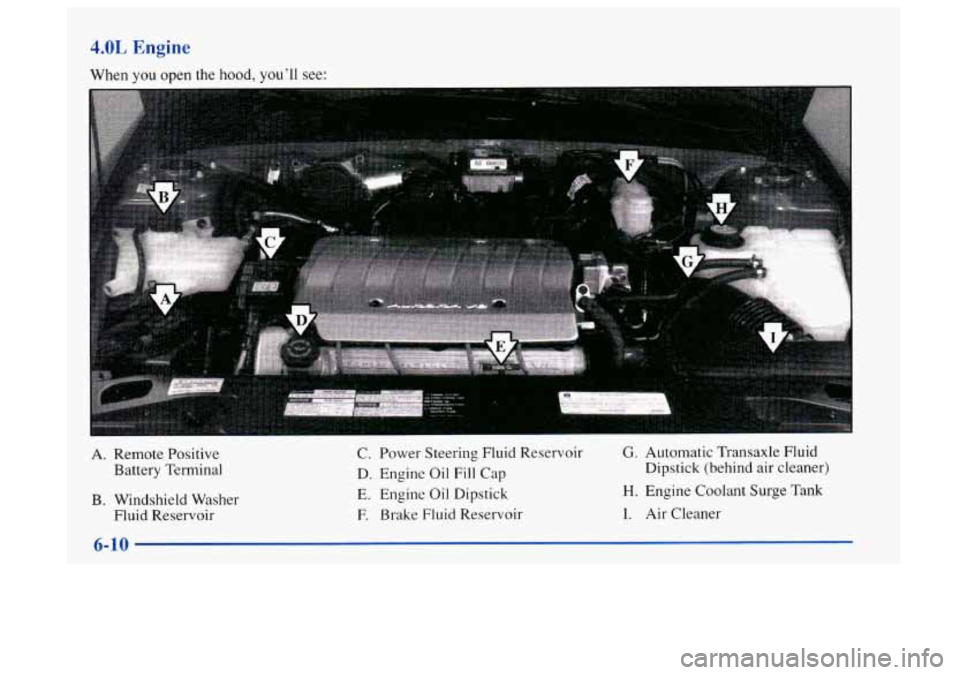
4.0L Engine
When you open the hood, you’ll see: ~
A. Remote Positive
Battery Terminal
B. Windshield Washer
Fluid Reservoir C. Power Steering
Fluid Reservoir
D. Engine Oil
Fill Cap
E. Engine Oil Dipstick
F. Brake Fluid Reservoir
G. Automatic Transaxle Fluid
Dipstick (behind air cleaner)
H. Engine Coolant Surge Tank
I. Air Cleaner
6-10
Page 271 of 404
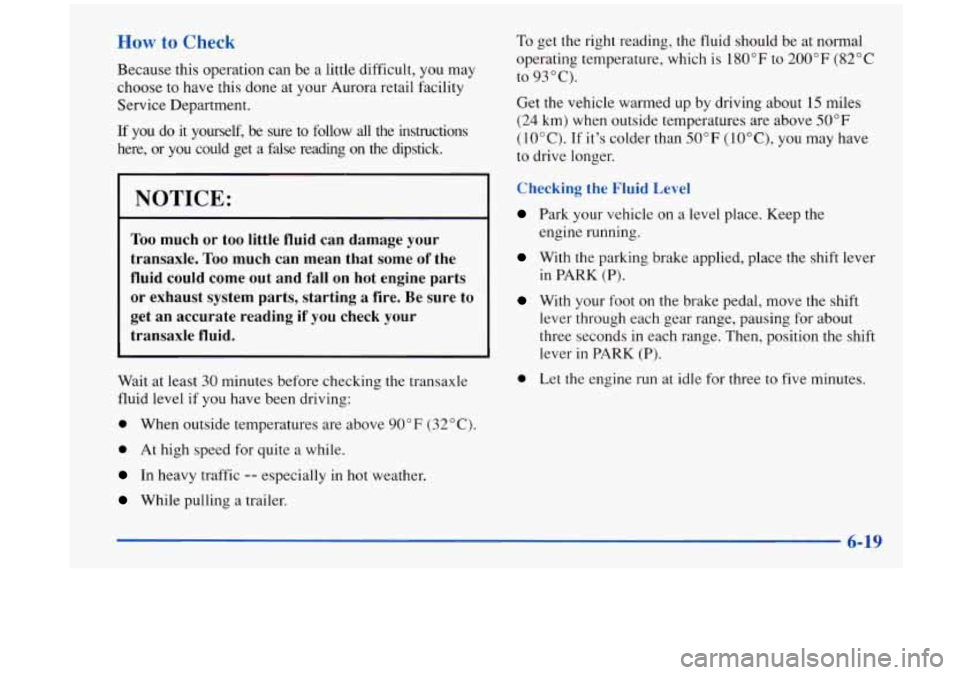
How to Check
Because this operation can be a little difficult, you may
choose to have this done at your Aurora retail facility
Service Department.
If you do it yourself, be sure to follow all the instructions
here, or
you could get a false reading on the dipstick.
To get the right reading, the fluid should be at normal
operating temperature, which
is 180°F to 200°F (82°C
to 93°C).
Get the vehicle warmed up by driving about
15 miles
(24 km) when outside temperatures are above 50°F
(10°C). If it's colder than 50°F (lO"C), you may have
to drive longer.
NOTICE:
Too much or too little fluid can damage your
transaxle.
Too much can mean that some of the
fluid could come
out and fall on hot engine parts
or exhaust system parts, starting a fire. Be sure to
get an accurate reading if you check your
transaxle fluid.
Wait at least 30 minutes before checking the transaxle
fluid level if
you have been driving:
0 When outside temperatures are above 90 OF (32 O C).
0 At high speed for quite a while.
In heavy traffic -- especially in hot weather.
While pulling a trailer.
Checking the Fluid Level
Park your vehicle on a level place. keep the
engine running.
With the parking brake applied, place the shift lever
in PARK
(P).
With your foot on the brake pedal, move the shift
lever through each gear range, pausing for about
three seconds in each range. Then, position the shift
lever in PARK (P).
0 Let the engine run at idle for three to five minutes.
Page 280 of 404
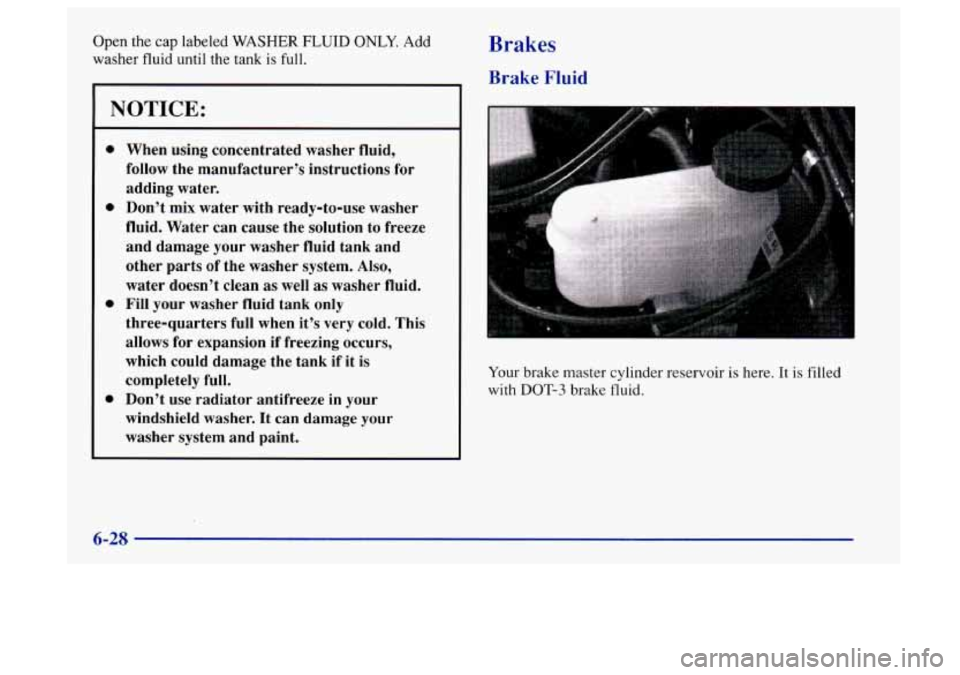
Open the cap labeled WASHER FLUID ONLY. Add
washer fluid until the tank is full.
NOTICE:
0
0
0
0
When using concentrated washer fluid,
follow the manufacturer’s instructions for
adding water.
Don’t mix water with ready-to-use washer
fluid. Water can cause the solution to freeze
and damage your washer fluid tank and
other parts of the washer system.
Also,
water doesn’t clean as well as washer fluid.
Fill your washer fluid tank only
three-quarters full when it’s very cold. This
allows for expansion if freezing occurs,
which could damage the tank if it
is
completely full.
Don’t use radiator antifreeze in your
windshield washer.
It can damage your
washer system and paint.
Brakes
Brake Fluid
Your brake master cylinder reservoir is here. It is filled
with DOT-3 brake fluid.
6-28